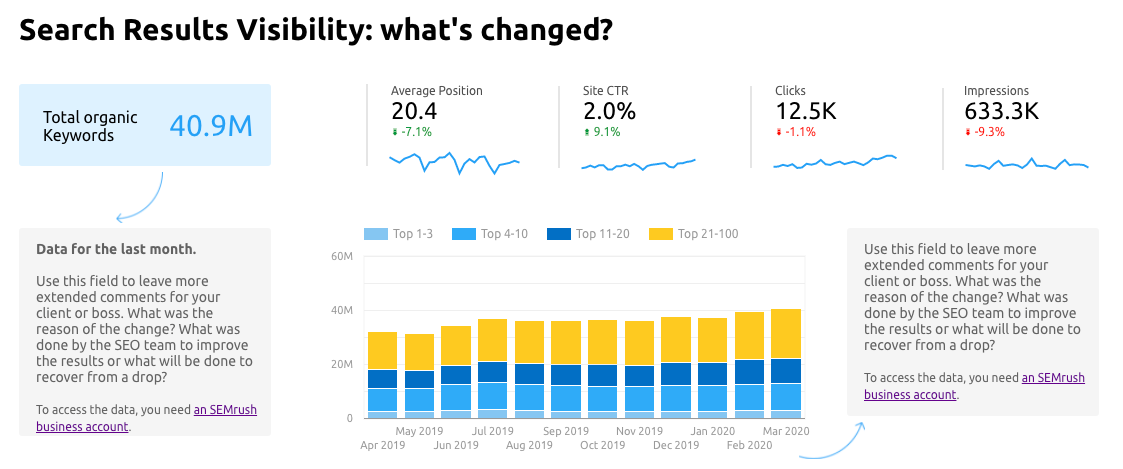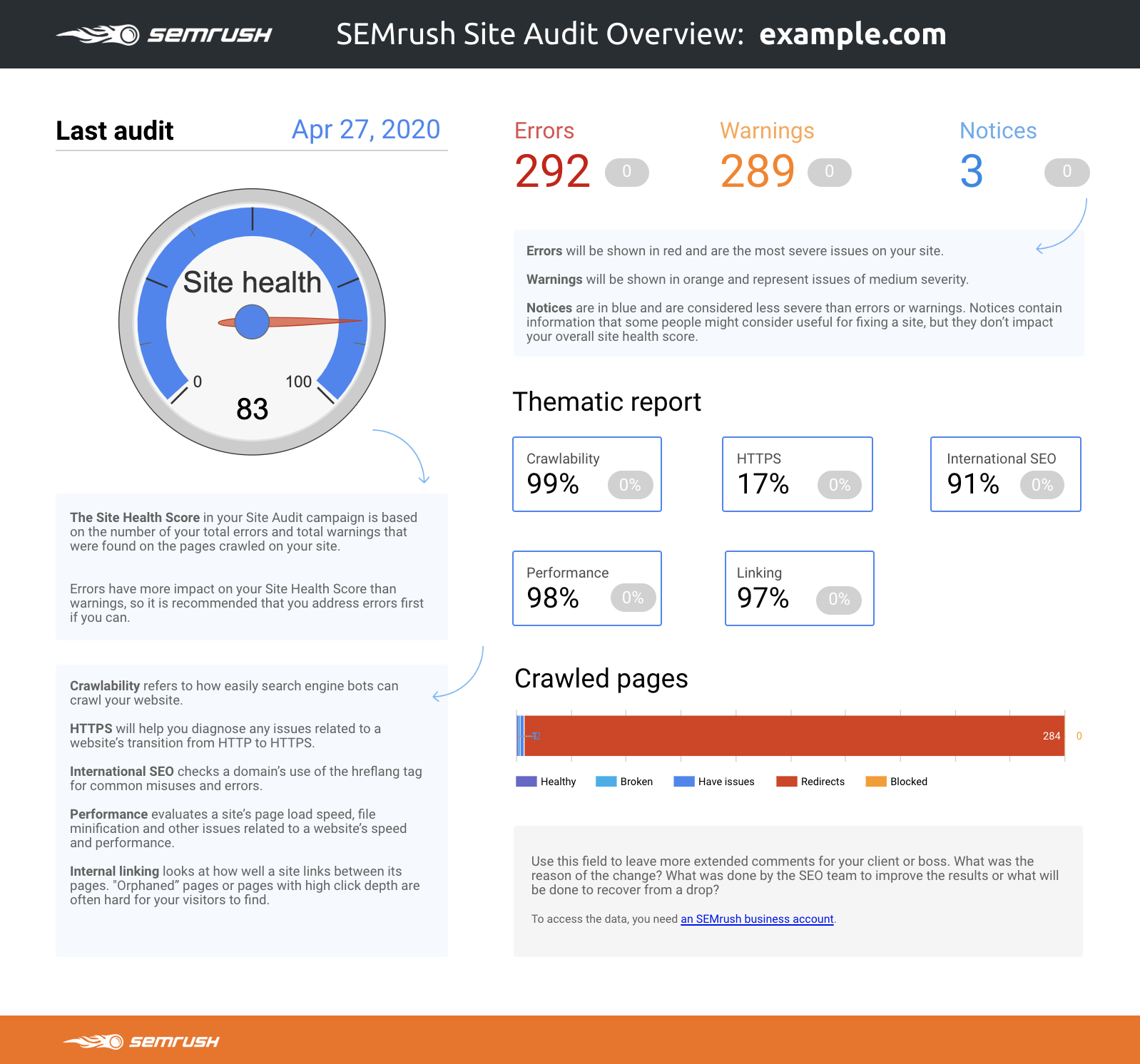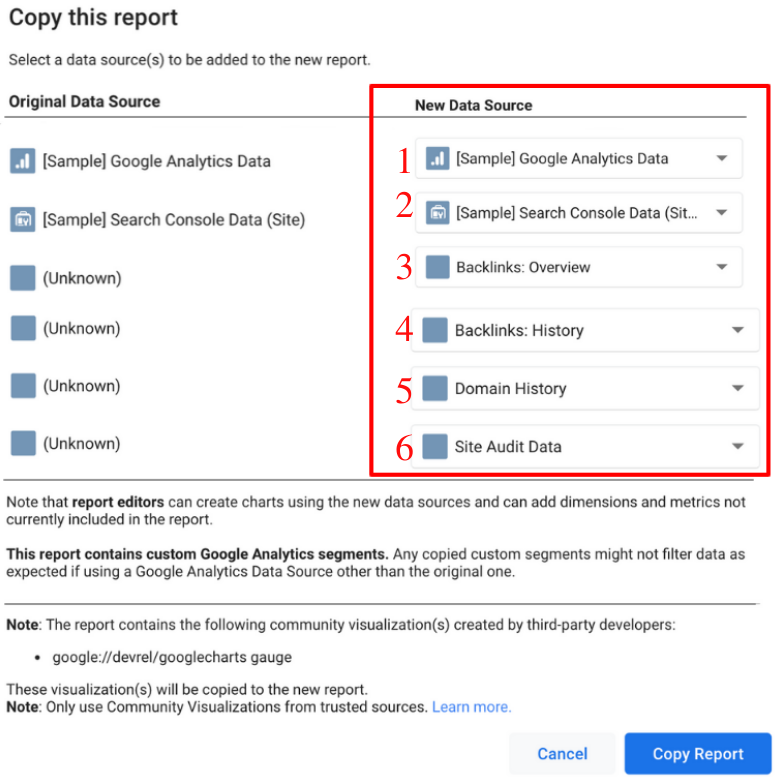How To Save A Google Data Studio Template
It is one matter to clarify data you can grasp every bit a marketing specialist. It is another to visualize it in an impactful way.
Data visualization gives y'all the power to plough masses of information into valuable insights to tell compelling stories that help y'all make information-driven decisions.
Yous can accomplish this with SEO reporting tools like Google Data Studio (GDS).
If you take ever dealt with GDS, terms similar "data blending", "custom segments" and "dimension breakdown" are likely to brand you lot shiver.
Despite its complexity, GDS is one of the almost powerful SEO reporting tools available. This is why we have developed a report template to help SEO specialists salve time on setting up dozens of widgets and fully understanding the tool itself.
 Click the image to get the template
Click the image to get the template
The report consists of three pages. The first page only requires access to Google Analytics, so you don't need a paid subscription to Semrush to make use of it. The second and third pages are based on Google Search Console and Semrush data.
With an Semrush Guru subscription, the combined report will allow you to send information to Information Studio and gain access to 40+ marketing tools for SEO, paid ad, content writing, social media direction, and marketing reporting.
Let's look at each part of the study in particular.
Source: Google Analytics

The Overview provides an instant view of the organic traffic state of affairs. The 3 most important elements of the Overview section are:
-
Organic traffic sessions
-
How this number changed over the determined fourth dimension menses (you can choice custom dates in the upper-correct part of the report)
-
The trend line over the past month (you lot tin can modify the date range in the Default date range section):

To the right of the Organic Sessions graph, you will find a serial of metrics that depict user behaviors:
-
Users
-
Bounce Rate
-
Pages / Session
-
Returning Users
-
% New Sessions
-
Boilerplate Session Duration
You can utilise the comments field to certificate any changes in your data.
If your results improved, was information technology because you managed to break into the pinnacle-iii positions for some high-volume keywords? Did newly implemented meta tags double the organic click-through charge per unit (CTR)? Did yous improve your site speed and bounce rate?
If your results worsened, was it because you lost featured snippets for some high-volume keywords? Did you lot experience any technical issues slowing the site down? Did a Google update hit your website?
The comment field can be useful to help you lot explicate changes to others and, if necessary, nowadays a recovery plan.
Source: Google Analytics

Business owners are not merely concerned about getting traffic. They need to empathise how and why it converts to help them achieve their business organization goals.
This is why this section of the report focuses on Total Goal Completions and the Goal Completions Tendency Graph to tell the full story.
The case higher up suggests that you keep track of the goal conversion and abandonment rates to spot potential technical issues, UX issues or irrelevant traffic, only you can manually add some of your most important goals to the written report yourself.
For case, a SaaS business may be tracking registrations, trials and payments to see how the users are moving through the sales funnel.
An e-shop can track unlike stages of purchase, such equally clicks on 'Add to cart', clicks on 'Proceed to payment', and payment completions.
The report can be tailored to arrange your needs when information technology comes to understanding how your traffic converts.
Source: Google Analytics

This department gives you a pinnacle-level idea of how Organic Search performs alongside your other marketing activities.
Large-scale Paid Search campaigns, for case, might affect Bounce Charge per unit and Average Session Elapsing; an SEO should be able to see whether or not that kind of activity has a knock-on effect on Organic operation.
To get a quick overview of Organic versus other channels, you can create a table with metrics such equally:
-
Sessions
-
% New Sessions
-
Bounce Rate
-
Boilerplate Session Duration
-
Goal Conversion Rate
-
Pages/Session
The tabular array is accompanied by a pie chart that visualizes the traffic sources and so you lot can get a clearer view of Organic Search's contribution.
Source: Google Search Panel

The 2d page of the report volition help y'all empathize your Organic performance in more particular.
The first section, dedicated to your visibility in the SERPs, includes:
-
Average Position: An boilerplate of your positions for every keyword for which you rank.
-
Site CTR: A sign of issues with snippets (meta titles and descriptions). CTR can also change when a competitor gets a featured snippet or other SERP feature for themselves.
-
Clicks: The actual number of unique times people clicked on your website on the search results folio.
-
Impressions: How many times your website appeared on the search results page (without necessarily being clicked on).
In the comment section of the written report, you can record the activities that made a departure to your visibility. You might accept rewritten your content according to best practices to get more clicks and impressions, or you might have worked on meta descriptions to heave CTR.
Remember that your visibility might decline because of competitor activity that is out of your control, and then you will want to monitor that in the Position Changes report and certificate it hither, too.
For a more than detailed breakdown of your visibility in the SERPs, yous can apply Semrush's Organic Analytics report.
Source: Semrush

Google Search Panel does not provide detailed statistics about the Organic positions you occupy for certain keywords, and so we take included both the full number of keywords and verbal positions hither.
You can view all keywords grouped according to your position in Google's search results.

This gives you a clearer picture of your search visibility and keyword performance and then you can identify opportunities to improve your Organic Search rankings.
Source: Semrush

Earning links is one of the biggest SEO challenges any website owner faces.
Checking the types of backlinks that point to your site and the Organic traffic they are driving can illustrate the effectiveness of your link building efforts.
Y'all can keep track of changes in your backlink profile in this department of the report template. It tin help you spot a sudden increase or decrease in the number of backlinks, which may provide the early warning signs that help you change your strategic form to avoid potential penalties.
An important metric to rails hither is the Dominance score. This is a compound domain score that measures the overall quality of a website according to its backlink profile.
It indicates both the number and quality of backlinks, as well as the associated strength of a domain.
The college the Dominance Score, the greater the trust in the domain, and then you tin can use it to understand whether or not your link edifice strategy is working for yous.
Source: Semrush

This section of the report shows the backlink trend for the past 12 months in terms of gains and losses.
This will permit yous to assess how successful and consistent your link building strategy has been over time. You will be able to spot seasonal trends at play, for example, or see if a shift in a company's content strategy affected the relevance of the links yous attract.
You can use the data to inform content writers, strategists or media buyers, too, for a more than comprehensive and connected approach.
Source: Semrush
The terminal page of the study provides an overview of a website's technical wellness.
Such improvements should be carried out alongside the likes of link building, new content cosmos and optimization of existing content, since overlooking any or all of these pillars can damage your overall search operation.

This is the quickest way to understand where your site stands in terms of technical health. It is the combined metric that takes into account over 130 checks, including everything from broken links to duplicate content.

The college the score, the 'healthier' your website is, but recall information technology's all relative. If you start with a score of 50 and improvements take y'all to 75, you are progressing well. If, all the same, yous accept been stuck on 75 for several months, you might need to revise your technical SEO strategy.
All the issues found during the audit are divided and colour-coded according to their severity:

- Errors: These are the most severe issues that demand to be prioritized, such as redirect chains, non-secure pages, 4XX status code and broken internal links.
- Warnings: These are secondary priorities, but they tin can however affect the overall health score. They include pages with a low discussion count, temporary redirects or cleaved external links.
- Notices: These are the least astringent issues that can be fixed terminal, such as pages with long URLs or more than than one H1 tag.
If you see new errors or warnings appearing since your last audit, check for more details nether the 'Issues' tab in your Site Inspect study, along with the recommendations on how to fix them.
This widget provides a breakdown of issues co-ordinate to their type:

- Crawlability: Details of how attainable your site is for crawlers regarding internal linking, page accessibility (HTTP status codes), unnecessary redirects and duplicates.
- HTTPS: Details of your certificates, the relevance of software on a server for security checks, and the lack of not-security resource available on an insecure protocol on a domain.
- International SEO: A score for how well your site is set upwards to deal with different languages and country codes, based on auditing for conflicts with page source code, and incorrect hreflang links.
- Performance: A score for a website's page loading speed and UX.
- Linking: A score for internal linking wellness, based on assessments of new 'orphaned' pages, broken internal links or pages that require many clicks to reach.
This final graph depicts the results for all the audited pages to broadly show you how much needs actioning and how much is salubrious.

Take note of how many pages are crawled in your audit. You can crawl up to xx,000 pages per project per month with a Guru subscription.
Here's a step-by-step caption of setting up a Google Data Studio SEO report template for yourself:
Starting time of all, add all data sources to Google Information Studio to ensure that all information will be pulled to your report when yous re-create the template.
To add Semrush data to your report, you need a Guru subscription to Semrush. Be sure to authorize your Google account and Semrush account to access data and add it to Google Data Studio.
Employ the following links to find the right connectors:
Google Analytics
Google Search Panel
Semrush Site Audit
Semrush Domain Analytics
To become information, choose a project that you accept created in Semrush. You can exercise this by selecting the respective project by its proper noun or specifying the project'due south ID, as follows:

To connect data from Semrush Domain Analytics, specify the Study type. To show the same information as the SEO report, you will need the post-obit:
-
Domain History
-
Backlinks: History
-
Backlinks: Overview

At present, set the parameters. Select a regional database for the Domain History study and a domain you lot would like to investigate for the iii reports mentioned above.
Next, click the Copy button to copy the template:

Y'all will see the popular-up window where you can select the data sources you need for your study. When copying the template, the Semrush reports will be displayed as Unknown. Since you have already added the right data sources to your account as described in Stride 1, all you have to do is simply select the data sources you need in the correct-hand side carte New Data Source in the order shown in the screenshot below:
- Google Analytics Data
- Google Search Console Information
- Backlinks: Overview
- Backlinks: History
- Domain History
- Site Audit Data

In the bottom-right corner, click Copy Report.
In the written report editor, you can switch between the two pages of the SEO report. Data displayed on the first folio is pulled from Google Analytics. This office is filtered by the Organic traffic segment.


Please note that we analyze merely Organic traffic in the widgets on page one. You can change it in the respective field:

The following part contains information about all goal completions:

You can modify how and which goals should exist represented in the written report in the right-hand side carte:

Information displayed on the 2d folio is pulled from unlike sources. Below, you can check which Google Data Studio connectors you need to get the respective widgets.
Google Search Console:

Semrush Domain Analytics (Domain History Written report):


Semrush Domain Analytics (Backlinks: Overview Report):

Semrush Domain Analytics (Backlinks: History Report):



Information displayed on the third folio (the Technical SEO Report) are based on information from the Semrush Site Audit reports. To pull this information to Google Data Studio, y'all need to accept created a project in Semrush.

Now that you have a fully customizable SEO report template, you can use it to inform changes to your strategy with your team and your client.
Google Information Studio is one of the about powerful marketing reporting tools. This GDS template is designed to assistance you speed up the reporting process.
If you think that nosotros missed anything or yous would like to see other widgets in the reporting template, let us know in the comments.
How To Save A Google Data Studio Template,
Source: https://www.semrush.com/blog/google-data-studio-seo-template/
Posted by: brownpromarged.blogspot.com


0 Response to "How To Save A Google Data Studio Template"
Post a Comment